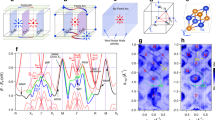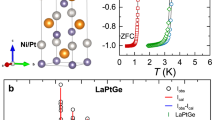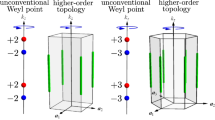Abstract
Weyl semimetals in three-dimensional crystals provide the paradigm example of topologically protected band nodes. It is usually taken for granted that a pair of colliding Weyl points annihilate whenever they carry opposite chiral charge. In stark contrast, here we report that Weyl points in systems that are symmetric under the composition of time reversal with a π rotation are characterized by a non-Abelian topological invariant. The topological charges of the Weyl points are transformed via braid phase factors, which arise upon exchange inside symmetric planes of the reciprocal momentum space. We elucidate this process with an elementary two-dimensional tight-binding model that is implementable in cold-atom set-ups and in photonic systems. In three dimensions, interplay of the non-Abelian topology with point-group symmetry is shown to enable topological phase transitions in which pairs of Weyl points may scatter or convert into nodal-line rings. By combining our theoretical arguments with first-principles calculations, we predict that Weyl points occurring near the Fermi level of zirconium telluride carry non-trivial values of the non-Abelian charge, and that uniaxial compression strain drives a non-trivial conversion of the Weyl points into nodal lines.
This is a preview of subscription content, access via your institution
Access options
Access Nature and 54 other Nature Portfolio journals
Get Nature+, our best-value online-access subscription
$29.99 / 30 days
cancel any time
Subscribe to this journal
Receive 12 print issues and online access
$209.00 per year
only $17.42 per issue
Buy this article
- Purchase on Springer Link
- Instant access to full article PDF
Prices may be subject to local taxes which are calculated during checkout






Similar content being viewed by others
Data availability
All other data that support the plots within this paper and other findings of this study are available from the corresponding authors upon reasonable request. Input files used to generate the first-principles data are provided in the Materials Cloud Archive71.
References
Wen, X.-G. Topological orders and edge excitations in fractional quantum Hall states. Adv. Phys. 44, 405–473 (1995).
Hasan, M. Z. & Kane, C. L. Colloquium: topological insulators. Rev. Mod. Phys. 82, 3045–3067 (2010).
Qi, X.-L. & Zhang, S.-C. Topological insulators and superconductors. Rev. Mod. Phys. 83, 1057–1110 (2011).
Fu, L. & Kane, C. L. Superconducting proximity effect and majorana fermions at the surface of a topological insulator. Phys. Rev. Lett. 100, 096407 (2008).
Kitaev, A. Periodic table for topological insulators and superconductors. AIP Conf. Proc. 1134, 22–30 (2009).
Ryu, S., Schnyder, A., Furusaki, A. & Ludwig, A. Topological insulators and superconductors: tenfold way and dimensional hierarchy. New J. Phys. 12, 065010 (2010).
Fu, L. Topological crystalline insulators. Phys. Rev. Lett. 106, 106802 (2011).
Slager, R.-J., Mesaros, A., Juričić, V. & Zaanen, J. The space group classification of topological band-insulators. Nat. Phys. 9, 98–102 (2012).
Bzdušek, T., Wu, Q.-S., Rüegg, A., Sigrist, M. & Soluyanov, A. A. Nodal-chain metals. Nature 538, 75–78 (2016).
Fang, C., Weng, H., Dai, X. & Fang, Z. Topological nodal line semimetals. Chin. Phys. B 25, 117106 (2016).
Bzdušek, T. & Sigrist, M. Robust doubly charged nodal lines and nodal surfaces in centrosymmetric systems. Phys. Rev. B 96, 155105 (2017).
Kruthoff, J., de Boer, J., van Wezel, J., Kane, C. L. & Slager, R.-J. Topological classification of crystalline insulators through band structure combinatorics. Phys. Rev. X 7, 041069 (2017).
Bouhon, A. & Black-Schaffer, A. M. Global band topology of simple and double Dirac-point semimetals. Phys. Rev. B 95, 241101 (2017).
Po, H. C., Vishwanath, A. & Watanabe, H. Symmetry-based indicators of band topology in the 230 space groups. Nat. Commun. 8, 50 (2017).
Bradlyn, B. et al. Topological quantum chemistry. Nature 547, 298–305 (2017).
Slager, R.-J. The translational side of topological band insulators. J. Phys. Chem. Solids 128, 24–38 (2019).
Höller, J. & Alexandradinata, A. Topological Bloch oscillations. Phys. Rev. B 98, 024310 (2018).
Zhang, T. et al. Catalogue of topological electronic materials. Nature 566, 475–479 (2019).
Autes, G., Wu, Q., Mounet, N. & Yazyev, O. V. TopoMat: a database of high-throughput first-principles calculations of topological materials. Materials Cloud Archive 2019.0019/v2 (2019); https://doi.org/10.24435/materialscloud:2019.0019/v2
Wan, X., Turner, A. M., Vishwanath, A. & Sergey Y., S. Topological semimetal and Fermi-arc surface states in the electronic structure of pyrochlore iridates. Phys. Rev. B 83, 205101 (2011).
Weng, H., Fang, C., Fang, Z., Bernevig, B. A. & Dai, X. Weyl semimetal phase in noncentrosymmetric transition-metal monophosphides. Phys. Rev. X 5, 011029 (2015).
Lv, B. Q. et al. Experimental discovery of Weyl semimetal TaAs. Phys. Rev. X 5, 031013 (2015).
Su-YangXu, I. et al. Discovery of a Weyl fermion semimetal and topological Fermi arcs. Science 349, 613–617 (2015).
Huang, X. et al. Observation of the chiral-anomaly-induced negative magnetoresistance in 3D Weyl semimetal TaAs. Phys. Rev. X 5, 031023 (2015).
Poenaru, V. & Toulouse, G. The crossing of defects in ordered media and the topology of 3-manifolds. J. Phys. Lett. 38, 887–895 (1977).
Volovik, G. E. & Mineev, V. P. Investigation of singularities in superfluid He3 in liquid crystals by the homotopic topology methods. Zh. Eksp. Teor. Fiz. 72, 2256–2274 (1977).
Madsen, L. A., Dingemans, T. J., Nakata, M. & Samulski, E. T. Thermotropic biaxial nematic liquid crystals. Phys. Rev. Lett. 92, 145505 (2004).
Alexander, G. P., Chen, B. G.-G., Matsumoto, E. A. & Kamien, R. D. Colloquium: disclination loops, point defects and all that in nematic liquid crystals. Rev. Mod. Phys. 84, 497–514 (2012).
Liu, K., Nissinen, J., Slager, R.-J., Wu, K. & Zaanen, J. Generalized liquid crystals: giant fluctuations and the vestigial chiral order of I, O and T matter. Phys. Rev. X 6, 041025 (2016).
Wu, Q., Soluyanov, A. A. & Bzdušek, T. Non-Abelian band topology in noninteracting metals. Science 365, 1273–1277 (2019).
Tiwari, A. & Bzdušek, T. Non-Abelian topology of nodal-line rings in \({\mathcal{PT}}\)-symmetric systems. Phys. Rev. B 101, 195130 (2020).
Ahn, J., Park, S. & Yang, B.-J. Failure of Nielsen–Ninomiya theorem and fragile topology in two-dimensional systems with space–time inversion symmetry: application to twisted bilayer graphene at magic angle. Phys. Rev. X 9, 021013 (2019).
Ahn, J., Kim, D., Youngkuk, K. & Yang, B.-J. Band topology and linking structure of nodal line semimetals with Z2 monopole charges. Phys. Rev. Lett. 121, 106403 (2018).
Cao, Y. et al. Unconventional superconductivity in magic-angle graphene superlattices. Nature 556, 43–50 (2018).
Po, H. C., Zou, L., Senthil, T. & Vishwanath, A. Faithful tight-binding models and fragile topology of magic-angle bilayer graphene. Phys. Rev. B 99, 195455 (2019).
Song, Z., Wang, Z., Shi, W., Li, G., Fang, C. & Bernevig, B. A. All magic angles in twisted bilayer graphene are topological. Phys. Rev. Lett. 123, 036401 (2019).
Bouhon, A., Black-Schaffer, A. M. & Slager, R.-J. Wilson loop approach to fragile topology of split elementary band representations and topological crystalline insulators with time-reversal symmetry. Phys. Rev. B 100, 195135 (2019).
Francis, G. K. & Kauffman, L. H. Air on the Dirac strings. Contemp. Math. 169, 261–276 (1994).
Johansson, N. & Sjöqvist, E. Optimal topological test for degeneracies of real Hamiltonians. Phys. Rev. Lett. 92, 060406 (2004).
Zhao, Y. X. & Lu, Y. PT-symmetric real Dirac fermions and semimetals. Phys. Rev. Lett. 118, 056401 (2017).
Milnor, J. W. & Stasheff, J. D. Characteristic Classes (Princeton Univ. Press, 1974).
Fukui, T., Hatsugai, Y. & Suzuki, H. Chern numbers in discretized Brillouin zone: efficient method of computing (spin) Hall conductances. J. Phys. Soc. Jpn 74, 1674–1677 (2005).
Soluyanov, A. A. et al. Type-II Weyl semimetals. Nature 527, 495–498 (2015).
Lv, B. Q. et al. Observation of three-component fermions in the topological semimetal molybdenum phosphide. Nature 546, 627–631 (2017).
Sun, X.-Q., Zhang, S.-C. & Bzdušek, T. Conversion rules for Weyl points and nodal lines in topological media. Phys. Rev. Lett. 121, 106402 (2018).
Zhu, Z., Winkler, G. W., Wu, Q., Li, J. & Soluyanov, A. A. Triple point topological metals. Phys. Rev. X 6, 031003 (2016).
Weng, H., Fang, C., Fang, Z. & Dai, X. Coexistence of Weyl fermion and massless triply degenerate nodal points. Phys. Rev. B 94, 165201 (2016).
He, J. B. et al. Magnetotransport properties of the triply degenerate node topological semimetal tungsten carbide. Phys. Rev. B 95, 195165 (2017).
Ma, J.-Z. et al. Three-component fermions with surface Fermi arcs in tungsten carbide. Nat. Phys. 14, 349–354 (2018).
Kresse, G. & Furthmüller, J. Efficient iterative schemes for ab initio total-energy calculations using a plane-wave basis set. Phys. Rev. B 54, 11169–11186 (1996).
Mostofi, A. A. et al. An updated version of Wannier90: a tool for obtaining maximally-localised Wannier functions. Comp. Phys. Commun. 185, 2309–2310 (2014).
Wu, Q., Zhang, S., Song, H.-F., Troyer, M. & Soluyanov, A. A. WannierTools: an open-source software package for novel topological materials. Comp. Phys. Commun. 224, 405–416 (2018).
Guo, S.-D., Wang, Y.-H. & Lu, W.-L. Elastic and transport properties of topological semimetal ZrTe. N. J. Phys. 19, 113044 (2017).
Sie, E. J. et al. An ultrafast symmetry switch in a Weyl semimetal. Nature 565, 61–66 (2019).
Li, T. et al. Bloch state tomography using Wilson lines. Science 352, 1094–1097 (2016).
Wilczek, F. & Zee, A. Appearance of gauge structure in simple dynamical systems. Phys. Rev. Lett. 52, 2111–2114 (1984).
Fläschner, N. et al. Experimental reconstruction of the Berry curvature in a Floquet Bloch band. Science 352, 1091–1094 (2016).
Lu, L., Fu, L., Joannopoulos, J. D. & Soljačič, M. Weyl points and line nodes in gyroid photonic crystals. Nat. Photon. 7, 294–299 (2013).
Lu, L. et al. Experimental observation of Weyl points. Science 349, 622–624 (2015).
Zilberberg, O. et al. Photonic topological boundary pumping as a probe of 4D quantum Hall physics. Nature 553, 59–62 (2018).
Nakahara, M. Geometry, Topology and Physics (Taylor & Francis, 2003).
Hatcher, A. Vector Bundles and K-Theory (Cornell Univ., 2017); https://pi.math.cornell.edu/~hatcher/VBKT/VB.pdf
Chern, S.-S. On the curvatura integra in a Riemannian manifold. Ann. Math. 46, 674–684 (1945).
Hatcher, A. Algebraic Topology (Cambridge Univ. Press, 2002).
Bzdušek, T. Euler Class of a Pair of Energy Bands on a Manifold with a Boundary (ResearchGate, 2019); https://doi.org/10.13140/RG.2.2.29803.69928
Kresse, G. & Joubert, D. From ultrasoft pseudopotentials to the projector augmented-wave method. Phys. Rev. B 59, 1758–1775 (1999).
Blöchl, P. E. Projector augmented-wave method. Phys. Rev. B 50, 17953–17979 (1994).
Perdew, J. P., Burke, K. & Ernzerhof, M. Generalized gradient approximation made simple. Phys. Rev. Lett. 77, 3865–3868 (1996).
Krukau, A. V., Vydrov, O. A., Izmaylov, A. F. & Scuseria, G. E. Influence of the exchange screening parameter on the performance of screened hybrid functionals. J. Chem. Phys. 125, 224106 (2006).
Örlygsson, G. & Harbrecht, B. The crystal structure of WC type ZrTe. Advantages in chemical bonding as contrasted to NiAs type ZrTe. Z. Naturforsch. B 54, 1125–1128 (1999).
Bouhon, A. et al. Supplementary data for ‘non-Abelian reciprocal braiding of Weyl points and its manifestation in ZrTe’. Materials Cloud Archive 2020.54 (2020); https://doi.org/10.24435/materialscloud:vb-mk
Acknowledgements
We acknowledge valuable discussions with C.C. Wojcik, A. Vishwanath and B.A. Bernevig. R.-J.S. acknowledges funding via A. Vishwanath from the Center for Advancement of Topological Semimetals, an Energy Frontier Research Center funded by the US Department of Energy Office of Science, Office of Basic Energy Sciences, through the Ames Laboratory under contract no. DE-AC02-07CH11358, the Marie Skłodowska-Curie programme under EC grant no. 842901, and Trinity College as well as the Winton programme at the University of Cambridge. T.B. was supported by the Gordon and Berry Moore Foundation’s EPiQS Initiative, grant no. GBMF4302, and by the Ambizione Program of the Swiss National Science Foundation, grant no. 185806. Q.-S.W. and O.V.Y. acknowledge support from NCCR Marvel. H.M.W. acknowledges support from the Ministry of Science and Technology of China under grants 2018YFA0305700 and 2016YFA0300600, the Strategic Priority Research Program of Chinese Academy of Sciences (grant no. XDB33000000) and the K. C. Wong Education Foundation (GJTD-2018-01). First-principles calculations have been performed at the Swiss National Supercomputing Centre (CSCS) under project no. s832 and s1008 and the facilities of Scientific IT and Application Support Center of EPFL.
Author information
Authors and Affiliations
Contributions
A.B., R.-J.S. and T.B. contributed equally to the theoretical analysis in this work and wrote the manuscript. Q.-S.W. discovered the nodal conversion in ZrTe and obtained the presented first-principles data. H.M.W. and O.V.Y. were involved in the discussion and analysis of the first-principles data. All authors discussed and commented on the manuscript.
Corresponding authors
Ethics declarations
Competing interests
The authors declare no competing interests.
Additional information
Publisher’s note Springer Nature remains neutral with regard to jurisdictional claims in published maps and institutional affiliations.
Extended data
Extended Data Fig. 1 Wilson loop computation of Euler class of two principal nodes in the presence of two adjacent nodes.
a-b Two possible flows of a base loop (lν, ν \(\in\) [0, 1]) over the punctured Brillouin zone containing two principal nodes (black) and excluding two adjacent nodes (grey). The flow starts at a base point (l0 = x0) and ends at the boundary \({l}_{1}=\partial {\rm{BZ}}-\partial {{\mathcal{D}}}^{\epsilon }\), with the orange arrow indicating the direction of the flow. Assuming that the pair of principal nodes were created first (along the dashed line between them), the Euler class is \(\chi [{\rm{BZ}}-{{\mathcal{D}}}^{\epsilon }]=0\) in case a, and \(\chi [{\rm{BZ}}-{{\mathcal{D}}}^{\epsilon }]=1\) in case b. c-f Wilson loop (c,d) and Pfaffian (e,f) as a function of the flow of base loop over the punctured Brillouin zone, that is corresponding to a for (c,e), and to b for (d,f). e The zero winding of the Pfaffian, Δζ = 0, indicates a trivial frame-rotation charge of the two principal nodes (that is zero Euler class on \({\rm{BZ}}-{{\mathcal{D}}}^{\epsilon }\)). f The non-zero winding of the Pfaffian, Δζ/(2π) = 1, indicates a non-trivial frame-rotation charge of the two principal nodes (that is non-vanishing Euler class on \({\rm{BZ}}-{{\mathcal{D}}}^{\epsilon }\)).
Extended Data Fig. 2 Fermi surface and band structures of ZrTe with and without strain.
a. Fermi surface of ZrTe under ambient conditions, with pairs of Weyl nodes of opposite chirality located inside the cyan pockets close to kz = 0 plane. b and c. Band structures of ZrTe along high-symmetry lines of the Brillouin under 0% resp. under 2.6% uniaxial compression strain. Path M-K-Γ lies within the kz = 0 mirror-invariant plane. The mirror eigenvalues + i and − i are indicated by the red vs. blue colour of the corresponding energy band. The plotted data were obtained with PBE+HSE06 functional.
Extended Data Fig. 3 Band structure of ZrTe.
Band structure of ZrTe as computed from PBE+HSE06 (left) resp. from PBE (right) functional.
Extended Data Fig. 4 Comparison of principal band nodes of ZrTe and MoP.
Band structure and location of nodal points of ZrTe and MoP, obtained with PBE+HSE06 functional. The band nodes in panels c and d correspond to degeneracies of energy bands marked with green and red colour in panels a and b.
Extended Data Fig. 5 Band structure and principal band nodes of ambient TaAs and with strain.
Band structure and band node locations in the first Brillouin zone of TaAs a–d under ambient conditions, and e–h with 5% [001] uniaxial strain obtained with PBE functional. The first column shows the band structure along the ΓX line. The next three columns show the location of band nodes in 3-dimension view, top view, and front view, respectively. Weyl points with chirality +1 and -1 are respectively indicated with magenta and green spheres. Nodal lines of the strained TaAs are indicated as brown lines. The \({C}_{2}{\mathcal{T}}\)-invariant plane is indicated with cyan colour, while the vertical mirror planes are displayed in shades of yellow.
Extended Data Fig. 6 Euler curvature in TaAs.
Euler curvature of a pair of Weyl points inside the \({C}_{2}{\mathcal{T}}\)-invariant plane of TaAs under ambient conditions. For a discussion, see Methods.
Extended Data Fig. 7 Band structure of nine WC-type materials obtained with PBE functional.
The corresponding nodal structure near the K-point under ambient conditions is indicated in each panel.
Supplementary information
Supplementary Information
Extra information for main text.
Rights and permissions
About this article
Cite this article
Bouhon, A., Wu, Q., Slager, RJ. et al. Non-Abelian reciprocal braiding of Weyl points and its manifestation in ZrTe. Nat. Phys. 16, 1137–1143 (2020). https://doi.org/10.1038/s41567-020-0967-9
Received:
Accepted:
Published:
Issue Date:
DOI: https://doi.org/10.1038/s41567-020-0967-9
This article is cited by
-
Non-Abelian Floquet braiding and anomalous Dirac string phase in periodically driven systems
Nature Communications (2024)
-
Anderson critical metal phase in trivial states protected by average magnetic crystalline symmetry
Nature Communications (2024)
-
Symmetry-protected topological exceptional chains in non-Hermitian crystals
Communications Physics (2023)
-
Three-dimensional non-Abelian Bloch oscillations and higher-order topological states
Communications Physics (2023)
-
Floquet non-Abelian topological insulator and multifold bulk-edge correspondence
Nature Communications (2023)



